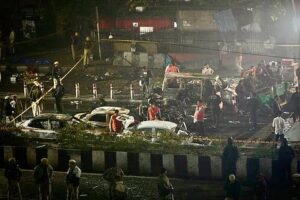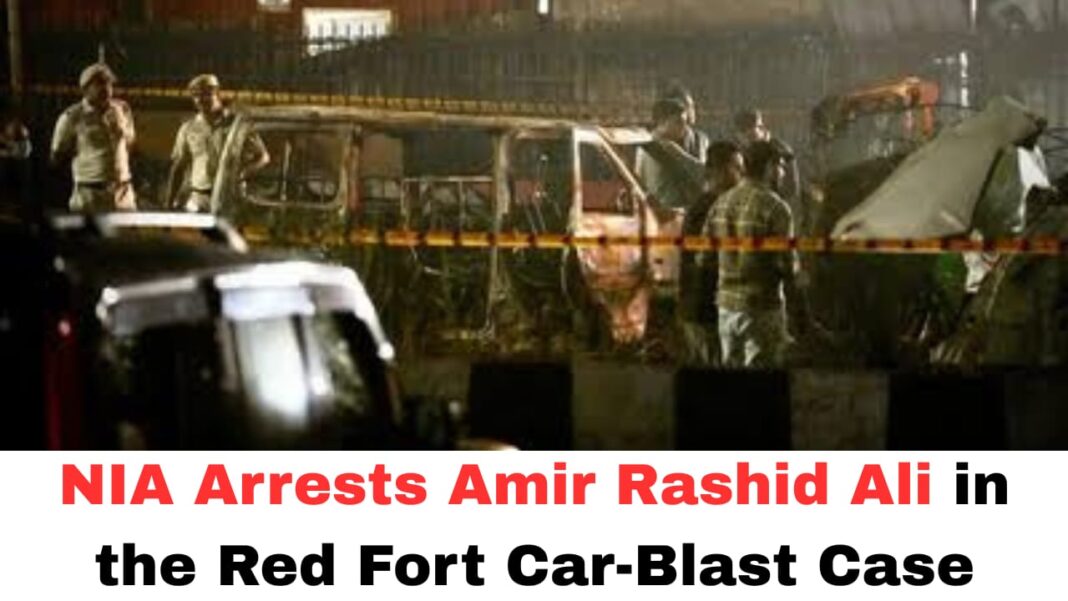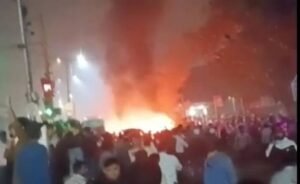Digital News Guru New Delhi Desk:
The NIA has arrested Amir Rashid Ali
In a significant development in the investigation into the Red Fort car explosion in New Delhi, India’s National Investigation Agency (NIA) announced the arrest of Amir Rashid Ali, a Kashmiri man, in connection with the deadly blast. The arrest is being hailed as a breakthrough in what authorities now classify as a terror attack.
The Incident: What Went Down
On 10 November 2025, a white Hyundai i20 exploded near Gate No. 1 of Red Fort Metro Station in New Delhi. The blast killed at least 13 people and injured more than 20. The NIA, taking over the investigation immediately, has characterized the event as a “vehicle-borne improvised explosive device” (VBIED) attack.

Who Is Amir Rashid Ali — and What Is He Accused Of?
According to the NIA, Amir Rashid Ali is not a peripheral figure; the car used in the attack was registered in his name. Investigators say Ali traveled from Kashmir to Delhi to facilitate the purchase of the Hyundai i20 that was eventually used in the explosion.
The NIA alleges that Ali conspired with the suspected suicide bomber, Dr. Umar Un Nabi, who has been identified as the driver of the vehicle.
The agency has also seized another vehicle belonging to Umar Nabi for forensic examination, suggesting that the car blast may have been part of a larger, coordinated effort.
The Bomber: Dr. Umar Un Nabi
The NIA identifies Dr. Umar Un Nabi, from Pulwama in Kashmir, as the individual behind the wheel of the i20. Nabi was reportedly a doctor associated with Al-Falah University in Faridabad, Haryana.
Further investigations have suggested a darker operational infrastructure: Nabi allegedly ran a secret explosive laboratory in his home.
Explosives Trail
- Ammonium nitrate has emerged as a key component in the bomb: forensic teams found over 2 kg of it in the wreckage.
- The NIA and Delhi Police have traced procurement of these materials to fertiliser dealers in Nuh district, Haryana, a region from where large quantities of NPK fertiliser and ammonium nitrate were allegedly stockpiled over months.
- According to investigators, the module may have planned multiple car bombs across cities: recovered documents and notes suggest they intended to convert several vehicles into IEDs.

Execution & Possible Motive
Authorities believe that Umar Nabi panicked after associates in his network were arrested. Some sources suggest that the IED may not have been fully assembled, hinting at a possible premature or accidental detonation, rather than a flawless suicide mission.
CCTV footage shows that Umar traveled alone before the blast, and investigators are now scrutinizing the route for signs of last-minute changes. Meanwhile, important technical clues emerged: the blast appears to have originated from the car’s bonnet, where traces of ammonium nitrate were later found.
Political & Security Repercussions
The incident has rattled senior leadership:
- Home Minister Amit Shah has directed all security agencies to relentlessly track down everyone involved.
- The cabinet of the Government of India has condemned the explosion as a “dastardly and cowardly act” and reiterated its commitment to “zero tolerance” on terrorism.
- Given the suspected involvement of a JeM-linked network and cross-border elements, the attack has raised concern over escalating security risks and interstate coordination.
Why the Arrest Matters
Amir Rashid Ali’s arrest is critical for several reasons:
- Chain of Culpability: Registering the blast car in his name directly ties him to the logistics of the attack, making him more than a peripheral supporter.
- Network Link: His alleged cooperation with Dr. Umar Nabi strengthens the narrative of a larger terror cell — not just a lone wolf operation.
- Milestone in Investigation: The NIA’s ability to sniff out and detain such a figure may provide leads to other members of the network and help prevent future attacks.
- Deterrence: A public arrest signals India’s resolve against terror, especially when “anti-national forces” are explicitly blamed.
Conclusion
The arrest of Amir Rashid Ali marks a turning point in the ongoing probe into one of Delhi’s deadliest attacks in recent memory. With the NIA zeroing in on both the logistics and the ideological network behind the blast, authorities hope to unravel a broader terror conspiracy. But as investigations deepen, the real challenge will lie in ensuring accountability for all operatives, dismantling procurement pipelines, and safeguarding public spaces from a potentially sophisticated threat network.
This episode underscores not just the immediate horror of the blast, but also the system-level vulnerabilities that enable terror cells to orchestrate such attacks — and the imperative for more coordinated, intelligence-driven counterterrorism operations.
You May Also Read: Indian Navy to Commission First Indigenous Mahe-Class ASW Vessel on 24 November









